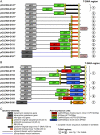The pCLEAN dual binary vector system for Agrobacterium-mediated plant transformation
- PMID: 17932303
- PMCID: PMC2151721
- DOI: 10.1104/pp.107.108563
The pCLEAN dual binary vector system for Agrobacterium-mediated plant transformation
Abstract
The development of novel transformation vectors is essential to the improvement of plant transformation technologies. Here, we report the construction and testing of a new multifunctional dual binary vector system, pCLEAN, for Agrobacterium-mediated plant transformation. The pCLEAN vectors are based on the widely used pGreen/pSoup system and the pCLEAN-G/pCLEAN-S plasmids are fully compatible with the existing pGreen/pSoup vectors. A single Agrobacterium can harbor (1) pCLEAN-G and pSoup, (2) pGreen and pCLEAN-S, or (3) pCLEAN-G and pCLEAN-S vector combination. pCLEAN vectors have been designed to enable the delivery of multiple transgenes from distinct T-DNAs and/or vector backbone sequences while minimizing the insertion of superfluous DNA sequences into the plant nuclear genome as well as facilitating the production of marker-free plants. pCLEAN vectors contain a minimal T-DNA (102 nucleotides) consisting of direct border repeats surrounding a 52-nucleotide-long multiple cloning site, an optimized left-border sequence, a double left-border sequence, restriction sites outside the borders, and two independent T-DNAs. In addition, selectable and/or reporter genes have been inserted into the vector backbone sequence to allow either the counter-screening of backbone transfer or its exploitation for the production of marker-free plants. The efficiency of the different pCLEAN vectors has been assessed using transient and stable transformation assays in Nicotiana benthamiana and/or Oryza sativa.
Figures




References
-
- Afolabi AS, Worland B, Snape JW, Vain P (2004) A large-scale study of rice plants transformed with different T-DNAs provides new insights into locus composition and T-DNA linkage configurations. Theor Appl Genet 109 815–826 - PubMed
-
- An G, Ebert PR, Mitra A, Ha SB (1988) Binary vectors. In SB Gelvin, RA Schilperoort, eds, Plant Molecular Biology Manual. Kluwer Academic Publishers, Dordrecht, The Netherlands, pp A3: 1–19
-
- Barrell PJ, Conner AJ (2006) Minimal T-DNA vectors suitable for agricultural deployment of transgenic plants. Biotechniques 41 708–710 - PubMed
-
- Becker D, Kemper E, Schell J, Masterson R (1992) New plant binary vectors with selectable markers located proximal to the left T-DNA border. Plant Mol Biol 20 1195–1197 - PubMed
Publication types
MeSH terms
Substances
Associated data
- Actions
- Actions
- Actions
- Actions
- Actions
- Actions
- Actions
- Actions
- Actions
- Actions
- Actions
- Actions
LinkOut - more resources
Full Text Sources
Other Literature Sources

